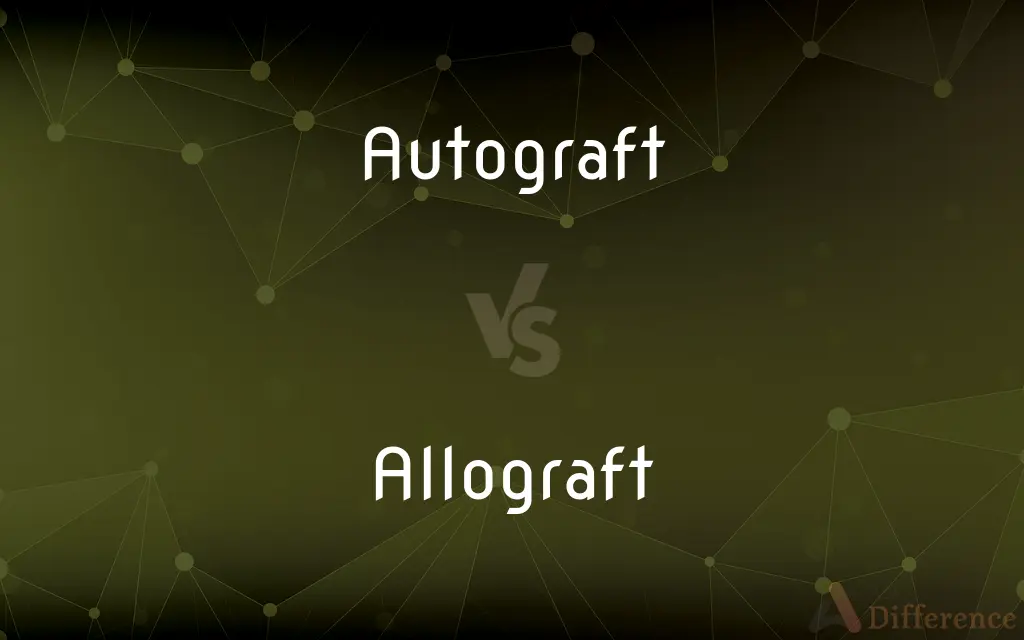Autograft vs. Allograft — What's the Difference?
By Fiza Rafique & Urooj Arif — Updated on March 12, 2024
Autograft involves transplanting tissue from one part of the body to another in the same individual, while allograft involves tissue transplanted from a donor to a recipient of the same species.

Difference Between Autograft and Allograft
Table of Contents
ADVERTISEMENT
Key Differences
Autografts are tissue transplants from one location to another within the same individual. This method is highly favored in various medical procedures due to the lower risk of rejection since the tissue originates from the patient's own body. For example, skin grafts for burn victims often use the patient's own skin from an unaffected area. On the other hand, allografts are tissues transplanted from a donor to a recipient, both of whom are of the same species but genetically different. Allografts are commonly used in organ transplants, such as kidneys or hearts, where tissue from a compatible donor is used to replace a failing organ in a recipient.
Autograft procedures inherently have a lower risk of immunological rejection because the graft is derived from the recipient's own body. This compatibility significantly reduces the complications associated with transplant rejection and the need for long-term immunosuppressive therapy. Conversely, allografts, while lifesaving, carry a higher risk of rejection. Recipients of allografts typically require lifelong immunosuppressive medication to prevent their immune system from attacking the transplanted tissue, which is recognized as foreign.
In terms of availability, autografts are limited by the amount of usable donor tissue available within an individual, which can be a significant constraint for large grafts or in individuals with extensive injuries or deficiencies. Allografts, although subject to the availability of compatible donors, can offer a wider range of tissue types and sizes, making them suitable for a variety of transplant needs, including large organ transplants or cases where the patient's own tissue is not viable for transplantation.
The recovery and healing process for autografts and allografts also differ. Autografts often result in two wound sites: the donor site and the recipient site, both of which require healing. However, the absence of immunological rejection can lead to a more straightforward healing process at the transplant site. Allograft recipients face a more complex recovery, managing not only the healing of the transplant site but also the potential side effects of immunosuppressive drugs and the risk of rejection.
Ethical and logistical considerations also vary between autografts and allografts. Autografts primarily involve considerations related to the patient's own body, such as the decision to undergo surgery and the potential impact on the donor site. In contrast, allografts introduce additional complexities, including donor consent, organ matching and allocation processes, and the ethical implications of organ donation and transplantation.
ADVERTISEMENT
Comparison Chart
Source of tissue
The patient's own body
A different individual of the same species
Risk of rejection
Low, due to genetic identity
Higher, requires immunosuppression
Availability
Limited by the patient's tissue availability
Dependent on donor availability
Healing process
Dual healing sites but no rejection
Complex due to potential rejection and drug side effects
Ethical/logistical considerations
Primarily patient-centric
Includes donor consent and organ allocation issues
Compare with Definitions
Autograft
Ensures high compatibility and low rejection risk.
An autograft was chosen to minimize rejection during the skin reconstruction.
Allograft
Tissue transplanted from one individual to another of the same species.
The kidney allograft from a compatible donor saved his life.
Autograft
Limited by available donor tissue.
The autograft required careful planning due to limited skin availability.
Allograft
Not limited by the recipient's condition.
An allograft was the best option due to the extensive damage.
Autograft
Involves healing at both donor and recipient sites.
Post-surgery, he cared for both the autograft and the donor site.
Allograft
Involves ethical considerations around organ donation.
The allograft process respected both donor consent and recipient need.
Autograft
Directly involves the patient as both donor and recipient.
She underwent an autograft procedure for her burn treatment.
Allograft
Carries a risk of rejection, requiring immunosuppression.
Following the allograft, she began immunosuppressive therapy.
Autograft
Tissue transplanted within the same individual.
The surgeon used an autograft from her thigh to repair the damaged skin.
Allograft
Healing is influenced by immunological factors.
Her allograft recovery involved monitoring for signs of rejection.
Autograft
A graft in which the tissue or organ is transplanted within the same individual, usually from one location to another.
Allograft
A tissue graft from a donor of the same species as the recipient but not genetically identical.
Autograft
(surgery) A tissue graft taken from one part to another of the same individual's body.
Allograft
A tissue or organ graft between genetically different individuals of the same species, as between two humans. Also called homograft.
Autograft
(transitive) To graft in this manner.
Allograft
(surgery) A surgical transplant of tissue between genetically different individuals of the same species.
Autograft
Tissue that is taken from one site and grafted to another site on the same person;
Skin from his thigh replaced the burned skin on his arms
Allograft
To perform a transplant of this kind.
Allograft
Tissue or organ transplanted from a donor of the same species but different genetic makeup; recipient's immune system must be suppressed to prevent rejection of the graft
Common Curiosities
When might an allograft be preferred over an autograft?
When the required tissue type or quantity is not available within the patient or for organ transplants.
How do autografts and allografts compare in terms of availability?
Autografts are limited by the patient's own tissue, while allografts depend on the availability of compatible donors.
What's the main difference between an autograft and an allograft?
An autograft is tissue from the same individual's body, while an allograft is from another individual of the same species.
How does the healing process differ between these graft types?
Autografts involve healing at both the donor and recipient sites without rejection issues, while allografts require managing rejection and immunosuppressive drug effects.
Can autografts be used for any type of tissue?
While versatile, autografts are limited by the type and amount of available donor tissue within the individual.
Why are autografts less likely to be rejected?
They are genetically identical to the recipient, reducing the immune system's likelihood of attacking the transplanted tissue.
What ethical considerations are unique to allografts?
Allografts involve issues like donor consent, ethical organ allocation, and ensuring equitable access to transplants.
What is the impact of tissue compatibility in allografts?
Compatibility impacts the risk of rejection; more compatible tissues reduce this risk and the intensity of needed immunosuppression.
What are the major risks associated with allografts?
The risks include immunological rejection and the side effects of long-term immunosuppressive therapy.
Can the use of autografts eliminate the need for immunosuppression?
Yes, because the tissue is from the same body, it significantly reduces or eliminates the need for immunosuppression.
Why might someone require immunosuppressive drugs after an allograft?
To prevent their immune system from attacking the transplanted tissue, which it recognizes as foreign.
How is patient consent handled in autograft procedures?
Patients must consent to both the removal and transplantation of their own tissue, understanding both benefits and risks.
Share Your Discovery

Previous Comparison
Define vs. Definition
Next Comparison
Purple vs. BurgundyAuthor Spotlight
Written by
Fiza RafiqueFiza Rafique is a skilled content writer at AskDifference.com, where she meticulously refines and enhances written pieces. Drawing from her vast editorial expertise, Fiza ensures clarity, accuracy, and precision in every article. Passionate about language, she continually seeks to elevate the quality of content for readers worldwide.
Co-written by
Urooj ArifUrooj is a skilled content writer at Ask Difference, known for her exceptional ability to simplify complex topics into engaging and informative content. With a passion for research and a flair for clear, concise writing, she consistently delivers articles that resonate with our diverse audience.
















































